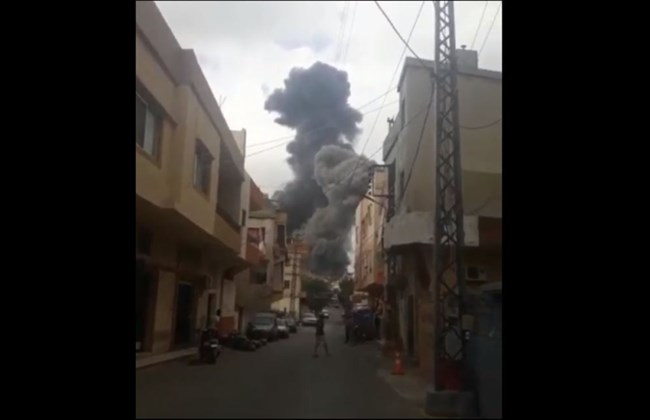In the afternoon of Tuesday, September 22 a massive explosion took place in the town of Ain Qana in southern Lebanon, at a house being used as a Hezbollah arms store.
Residents of the town, which lies around 50 km south of Beirut in an area with strong ties to the militant group, were the first to raise concerns that the building was being used by Hezbollah to store weapons. Then a security source told Reuters: “The explosion occurred as a result of a technical error in one of the party’s weapons warehouses.”
The sheer scale of the blast and the amount of billowing black smoke at first led many to assume it had been a gas station explosion. Video footage posted on social media showed the destruction of neighboring houses and the burnt-out surrounding land. Hezbollah operatives surrounded the area and blocked both passersby and journalists from approaching the scene.
According to the National News Agency, the explosion occurred at the same time as Israeli warplanes and intelligence aircraft were flying over nearby Nabatieh and Iqlim Al-Tuffah.

But Ali Ammar, a Hezbollah MP , refused to speculate on the cause of the blast, saying only: “Wait for Hezbollah’s official statement.”
Four hours after the incident, the Lebanese army issued a statement confirming the explosion had taken place at 3pm local time and it was investigating. In a separate statement, it also confirmed that “violations of Lebanese airspace” by Israeli planes had taken place in the run-up to the incident.
A Gas Station has reportedly exploded in Ain Qana, Southern #Lebanon. pic.twitter.com/HXLCOFssjA
— Aurora Intel (@AuroraIntel) September 22, 2020
George Kittana, Secretary-General of the Lebanese Red Cross, told LBC: “The Red Cross received a call when the explosion occurred and ambulances were sent to the site. According to preliminary information, there were no civilian casualties.”
In the aftermath of the incident, Lebanese social media users seized on tweets from an account called Alex Benjamin. This individual’s tweets are protected but he identifies himself as a journalist at Reporters Without Borders and former Hezbollah detainee, now living in Norway.
هذه الصورة في بلدة عين قانا جنوب #لبنان . في المكان المشار اليه يستعمل عناصر #حزب_الله_ارهابي عدد من المنازل لما يسمى وحدة الهندسة حيث يتم في هذا المكان تصنيع عبوات (رعد ، سجيل ، عاصف) . في هذا المكان قرب منازل الامنين يوجد مخزن فيه اطنان من ( C4 , RDX , TNT ) pic.twitter.com/ygA3Pfwj3w
— Alex Benjamin (@Alexbenjamin87) August 7, 2020
On August 7, three days after the Beirut Port explosion, Benjamin had tweeted about Hezbollah using a number of homes in Ain Qana as warehouses for “engineering units” to make explosives. Inside these buildings, he claimed, were tons of C-4, RDX and TNT.
In addition, he said, a store of electric detonators and live ammunition was hidden inside a factory in Ain Qana being promoted as a cheese and milk store. This factory, he claimed, had opened in 2008 around the time of the assassination of then-Hezbollah number two Imad Mughniyeh.
The incident in Ain Qana took place a month and a half after the devastating explosion at Beirut Port on August 4, which is now known to have caused at least 200 deaths and 6,500 injuries while laying waste to homes and infrastructure for miles around.
Lebanon’s economy is already on the brink of collapse and since the mass resignation of the cabinet, politicians have yet to agree on how to form a new government. For the time being, officials are staying on in a “caretaker” capacity despite the shadow of Hezbollah control hanging over several ex-ministers.
IRAN WIRE
Leave a Reply
You must be logged in to post a comment.